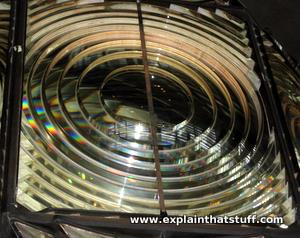
Optics
Barton had pretty good eyesight throughout his life, but not so with Mr. Higgins at the poorhouse.
Mr. Higgins wore eyeglasses.
We began this subject by talking about wood ashes, which produces potash.
Then we talked about making glass, which requires potash or soda-ash,
and now we will discuss optical glass which people need, to see, in different ways.
What optical devices existed in Barton’s time?
1) Deck prisms (invented in 1840), brought light into the bottom decks of the old ships.
2) Mirrors, which aid vanity, distribute light, and are used in ‘reflecting telescopes’.
3) Eyeglasses (1290), for near-sightedness or far-sightedness
4) Magnifying glasses, which are portable reading glasses.
5) Magnifying lenses for microscopes. You'll read more on this, in the article about Joseph Lister.
6) Binoculars (1825) and telescopes (1608), for birdwatching, star-gazing or spotting pirate ships.
7) Civil War photography used glass plates for taking pictures.
8) Fresnel lenses, (1822, photo above) which enabled a lighthouse’s light beam reach up to 20 miles out to sea.
9) And…I probably missed a few things.
From sand, seashells or limestone, and wood ashes, comes an instrument that lets us see tiny germs or moon craters. Amazing.
But when we talk about high-quality optical glass, like telescopes and microscopes, we have to note:
A piece of flat window glass gives a 1-for-1 image of what we are looking at,
yet another type of glass help us see the craters in the moon,
and another helps us see germs.
How does that work?
I can only touch on the subject, for you to study later. Learn these three terms:
Plane glass: Gives an accurate image of what we see.
Concave glass: Distorts images in one direction.
Convex glass: Distorts images in the opposite direction.
Every soup spoon has both a 'concave' surface and a 'convex' surface.
The side of the spoon that ‘caves-in’ to hold the food is the concave side.
The side that pushes out, is the convex side.
A lot of optical-aids do their work, by using some combination of glass shapes,
ground and polished to either a convex or concave surfaces, (and mirrors)
to manipulate rays of light to produce an enhanced image for us.
(sorry for the long sentence)
There is too much information about optical glass to give here, but this is a sample.
And Fresnel lenses are really cool, and a part of why I really like lighthouses.
Eric J. Rose
middlegrademysteries.com
photo: explainthatstuff.com